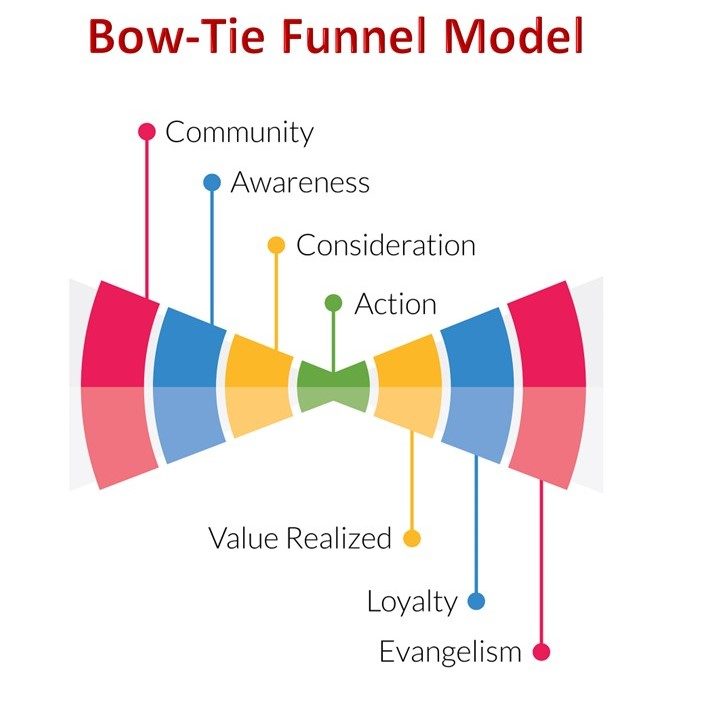The Bow-Tie Model: A Rising Star in B2B Marketing

Summary
This blog post introduces the bow-tie model as an increasingly popular B2B marketing strategy that offers a more comprehensive view of the customer journey compared to the traditional funnel model, addressing both pre- and post-purchase stages. Highlighting the bow-tie model's emphasis on brand trust and customer loyalty, ability to track customer growth, personalized marketing activities, effective lead nurturing, and provision of pricing strategies catering to various customer needs, the author posits it as an effective tool for optimizing marketing strategies, fostering long-term customer relationships, and driving business growth.
By Cameron Katoozi, Marketing Consultant at Heinz Marketing
In recent years, the bow-tie model has emerged as a popular framework in B2B marketing. While the traditional funnel model has been the go-to for many years, the bow-tie model is gaining popularity as a more comprehensive approach to customer engagement and revenue generation. The model offers distinct advantages that are increasingly relevant in today’s B2B landscape. This innovative model offers several advantages over the traditional funnel model, making it an attractive option for businesses looking to optimize their marketing strategies. In this blog, we will explore why the bow-tie model is becoming popular in B2B marketing and what advantages it has over the traditional funnel model.
The Traditional Model
A key reason why the bow-tie model is gaining popularity is that it offers a more holistic view of the customer journey. The traditional funnel focuses on the pre-sale stage; primarily on the customer acquisition process of guiding prospects through awareness, consideration, and decision stages until they make a purchase. Once the sale is made, the funnel model often neglects the post-sale stage, where the focus shifts to customer retention and loyalty. In contrast, the bow-tie model recognizes that the customer journey is not linear and that the post-sale stage is just as important as the pre-sale stage. The bow-tie model addresses this shortcoming by incorporating both pre- and post-purchase stages, creating a more holistic view and more effective marketing strategy that meets the needs of customers at every stage.
What is the bow-tie model?
The model typically consists of five stages: (1) Awareness, (2) Consideration, (3) Selection, (4) Implementation, and (5) Post-Implementation. Visually, it’s divided into two halves, with the moment of purchase/closed deal at the center. The left side represents the traditional sales funnel, with a focus on building awareness and consideration. The right side focuses on post-purchase stages, including adoption, retention, expansion, and customer support/follow-up. This dual approach allows businesses to not only acquire new customers but also nurture existing ones, ultimately driving long-term growth and success.
Advantages of the Bow-Tie Model
One of the key advantages of the bow-tie model is its emphasis on brand trust and customer loyalty. As explained by Jacco van der Kooij in a Winning by Design video, the majority of revenue in a Sales as a Science approach is made after the sale. By focusing on post-purchase stages such as customer support and follow-up, businesses can capitalize on their existing customer base, which is often a more cost-effective strategy than solely concentrating on new customer acquisition. Implementing the right side of the bow-tie also provides more consideration of customer feedback and input, giving companies a better customer perspective to improve products and services. In turn, B2B companies can improve customer satisfaction and increase the likelihood of repeat business with a more customer-centric approach to marketing.
Another benefit of the bow-tie model is its ability to track customer growth and measure the drivers that impact total revenue. By analyzing data such as lookalike, clickstream, and attribution information, businesses can gain valuable insights into customer behavior and preferences, allowing them to tailor their marketing efforts for maximum impact. Another area of concern with the traditional model is failing to recognize that different customers have various needs and preferences. In the traditional funnel model, the focus is on moving all prospects through the same linear path. In contrast, the bow-tie model acknowledges that different customers have different needs and preferences and that marketing activities should be tailored accordingly. By personalizing marketing activities to meet the needs of individual customers or personas, B2B companies can create a more effective marketing strategy that resonates with prospects.
The bow-tie model also offers advantages in terms of lead generation and lead nurturing. In the traditional funnel model, the focus is on generating as many leads as possible and then filtering them down to a smaller group of qualified leads. This approach can lead to a high volume of unqualified leads, which can be a waste of time and resources. In contrast, the bow-tie model emphasizes the importance of lead nurturing, which involves building relationships with prospects over time and providing them with relevant content and information that meets their needs. The bow-tie model can help businesses identify areas where organizational gaps are, enabling them to implement proactive, sustainable strategies to improve performance, such as lead nurturing. This way, B2B companies can build stronger relationships with prospects and increase the likelihood of a successful sale.
Wrapping it up
In conclusion, the bow-tie model offers a more comprehensive and effective approach to B2B marketing than the traditional funnel model. It encourages businesses to optimize their pricing strategies to empower customer retention and growth. By offering pricing options that cater to different customer needs and preferences, businesses can foster long-term relationships and encourage repeat purchases, ultimately boosting their bottom line. Incorporating both pre- and post-purchase stages, emphasizing brand trust and customer loyalty, and providing valuable insights into customer behavior, the bow-tie model enables businesses to optimize their marketing strategies for long-term growth. As more organizations recognize the benefits of this innovative approach, the bow-tie model is set to continue being an increasingly popular choice for many B2B marketers moving forward.





